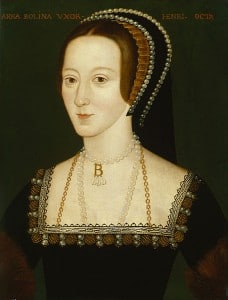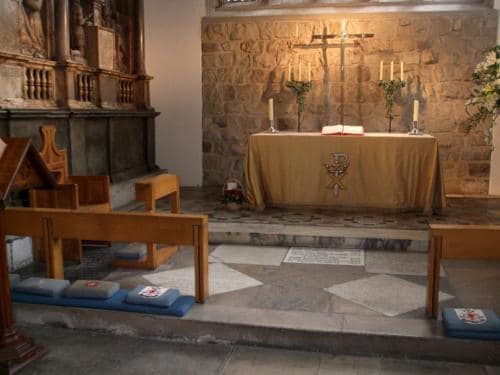 I’m not sure whether Anne Boleyn got any sleep on the night of the 18th/19th May. She was certainly up at dawn, celebrating the Mass and receiving the sacrament from her almoner John Skip. She then ate breakfast and waited for Sir William Kingston, Constable of the Tower of London, to come and collect her.
I’m not sure whether Anne Boleyn got any sleep on the night of the 18th/19th May. She was certainly up at dawn, celebrating the Mass and receiving the sacrament from her almoner John Skip. She then ate breakfast and waited for Sir William Kingston, Constable of the Tower of London, to come and collect her.
At 8am, Kingston informed the waiting queen that the time of her death was near and that she should get herself ready. But Anne was ready. She had taken special care with her outfit – the ermine trim symbolised royalty and crimson, the colour of her kirtle, was associated with martyrdom. Her hood was the traditional English gable hood, rather than her usual stylish French hood.
Sir William Kingston escorted the Queen from her apartments in the royal palace past the Great Hall, through Cole Harbour Gate (Cold Harbour Gate), and along the western side of the White Tower to the black-draped scaffold. The site of the scaffold built for Anne Boleyn was not where the glass memorial stands today on Tower Green but “before the house of Ordnance”, i.e. on the parade ground between the White Tower and the present day entrance to the Crown Jewels.1 Anne climbed the scaffold steps with Kingston’s assistance and then addressed the waiting crowd:
“Good Christian people, I have not come here to preach a sermon; I have come here to die. For according to the law and by the law I am judged to die, and therefore I will speak nothing against it. I am come hither to accuse no man, nor to speak of that whereof I am accused and condemned to die, but I pray God save the King and send him long to reign over you, for a gentler nor a more merciful prince was there never, and to me he was ever a good, a gentle, and sovereign lord. And if any person will meddle of my cause, I require them to judge the best. And thus I take my leave of the world and of you all, and I heartily desire you all to pray for me.”
That speech is corroborated by Edward Hall, George Wyatt, John Foxe and Lord Herbert of Cherbury, but Lancelot de Carles, secretary to the French ambassador, gives a different version in his poem about her death:
“Oh my friends, friends and more than brothers,
Since with you I can no longer be,
And that the course of my years is ended,
I beg you, not to be unpleasant, /And I
would like you to pardon me from your good heart
If I have not used sweetness
Towards all of you, as I should have,
Seeing the power and means that I had:
And I pray you all that by fraternity
Of Christianity and true charity,
You give me a place in your devoted prayers
Toward Jesus, that by the marks
Of my sins I have not stained
My soul, after I am gone.
To tell you why I am here,
Would not serve you nor me either:
Which is why I am silent, but the judge of the world
In whom justice and truth abound
Knows all, that which of affection
I pray that he will have compassion
For those who judged my death,
And from here when I am dislodged.
You remember that I recommend you to
Your good King in whom I have seen such great
Humanity, and filled with all good things,
Fears God, loves his family,
And great virtue, which I observe
That is happy if God conserves it for you.
Pray then to God that he holds you a long time:
also, that it happens to me
His grace to move me away to him
And to receive my soul today.”2
People often ask me why Anne Boleyn did not take the opportunity to protest her innocence and why she spoke well of the King. Well, executions were carefully ‘choreographed’, with a set format for execution speeches. People were expected to die ‘a good death’ and accept that they were sinners deserving of death, whether or not they were guilty of the crimes they were being executed for, and to praise the monarch, who was God’s anointed sovereign. People had their surviving loved ones to think about and would not have wanted to tarnish their reputations and standing with the King by dying a dishonourable death. Anne stuck to the usual format for her execution speech. There was no way that she would risk her daughter’s safety by defying the King and proclaiming her innocence. Elizabeth’s safety and her future relationship with her father must have been paramount in Anne’s mind.
After her speech to the crowd, who were “little consoled, [Deeply] desolated to see the poor queen In this state to take in this pain”,3 Anne paid the visibly “distressed”4 executioner who asked for her forgiveness for what he was about to do. Anne’s ladies then removed Anne’s mantle and Anne lifted off her gable hood. “A young lady presented her with a linen cap, with which she covered her hair, and she knelt down, fastening her clothes about her feet, and one of the said ladies bandaged her eyes.”5 Anne knelt on the scaffold praying, “O Lord have mercy on me, to God I commend my soul. To Jesus Christ I commend my soul; Lord Jesu receive my soul.” As Anne prayed, the executioner called out to his assistant to pass him his sword. As Anne moved her head to try and hear what the assistant was doing, the executioner came up unnoticed behind her and beheaded her with one stroke of his sword.
Anne’s ladies, “Who were judged to be nearly dead themselves, From languor and extreme weakness”,6 wrapped her remains in white cloth and took them to the Chapel of St Peter ad Vincula for burial. No casket had been provided, so a yeoman warder fetched an old elm chest which had once contained bow staves from the Tower armoury.7 Anne’s head and body were buried together in the chest in the chancel of the chapel. Cannons fired to let the people of London know that their queen had been executed and Sir Francis Bryan took news of Anne’s death to Jane Seymour.

Also, on this day in 1536, Archbishop Thomas Cranmer issued a dispensation for Henry VIII to marry Jane Seymour “although in the third and third [Tertio et tertio affinitatis gradibus] degrees of affinity, without publication of banns.”
Notes and Sources
- Eric Ives pieced together Anne Boleyn’s final walk and the location of the scaffold, which was newly built especially for her, for his book The Life and Death of Anne Boleyn, from sources including Anthony Anthony’s notes in Lord Herbert’s 1679 edition of The Life and Raigne of Henry VIII, Lisle Letters Volume 3:698, and writes of her being “beheaded on a new scaffold ‘before the house of Ordnance’”. See notes on p423 of Ives’ book.
- You can read the original French poem in Poème sur la Mort d’Anne Boleyn, Lancelot de Carles, lines 317-326, in La Grande Bretagne devant L’Opinion Française depuis la Guerre de Cent Ans jusqu’a la Fin du XVI Siècle, George Ascoli. This translation is from “Anne Boleyn, Lancelot de Carle, and the Uses of Documentary Evidence”, Susan Walters Schmid, dissertation Arizona State University 2009, p170-172.
- Ibid., p172.
- Letters and Papers, Foreign and Domestic, Henry VIII, Volume 10 – January-June 1536, 919.
- Ibid., 911.
- Lancelot de Carles, Susan Walters Schmid, p174.
- Younghusband, George, The Tower from Within, 135.